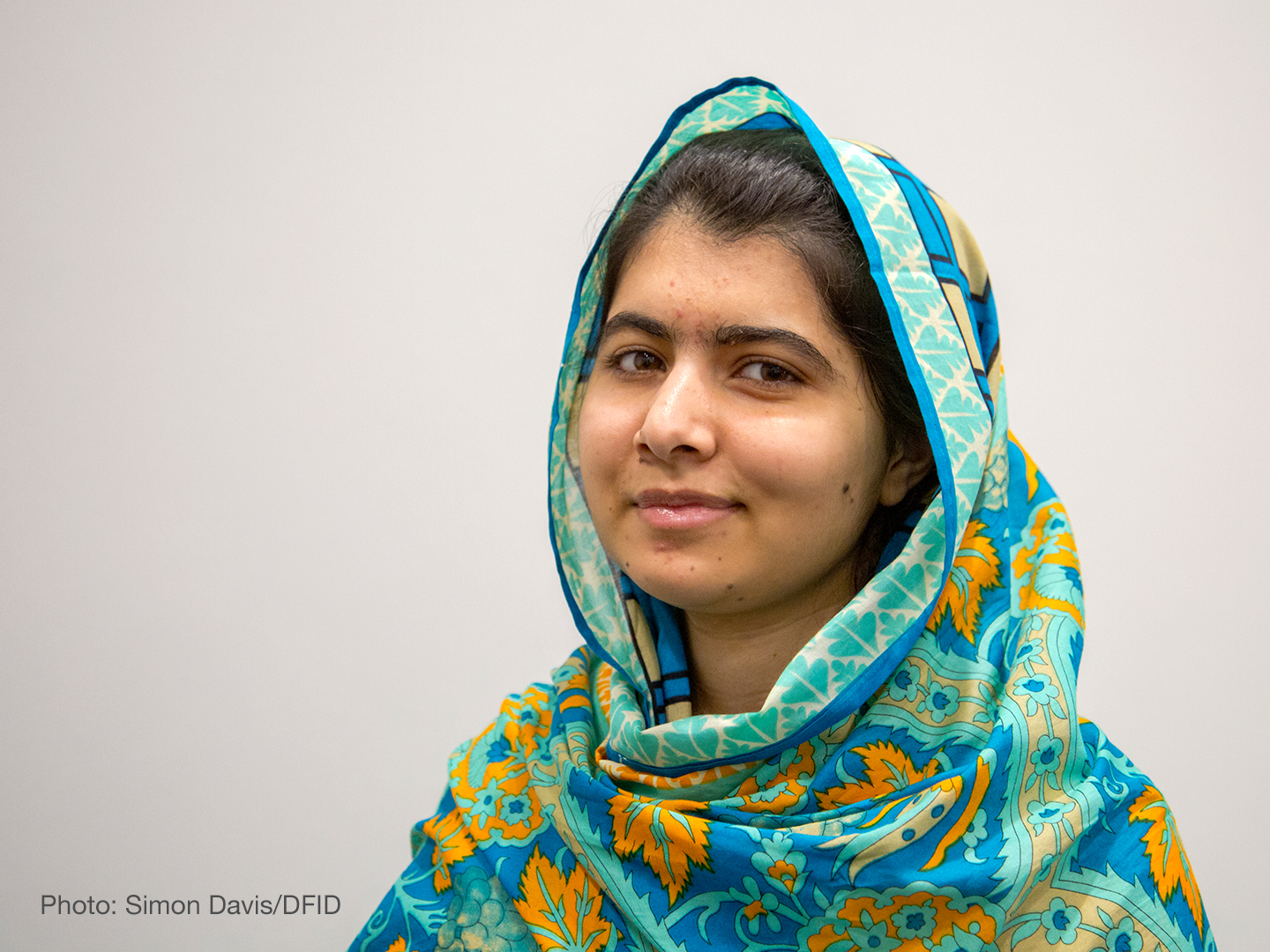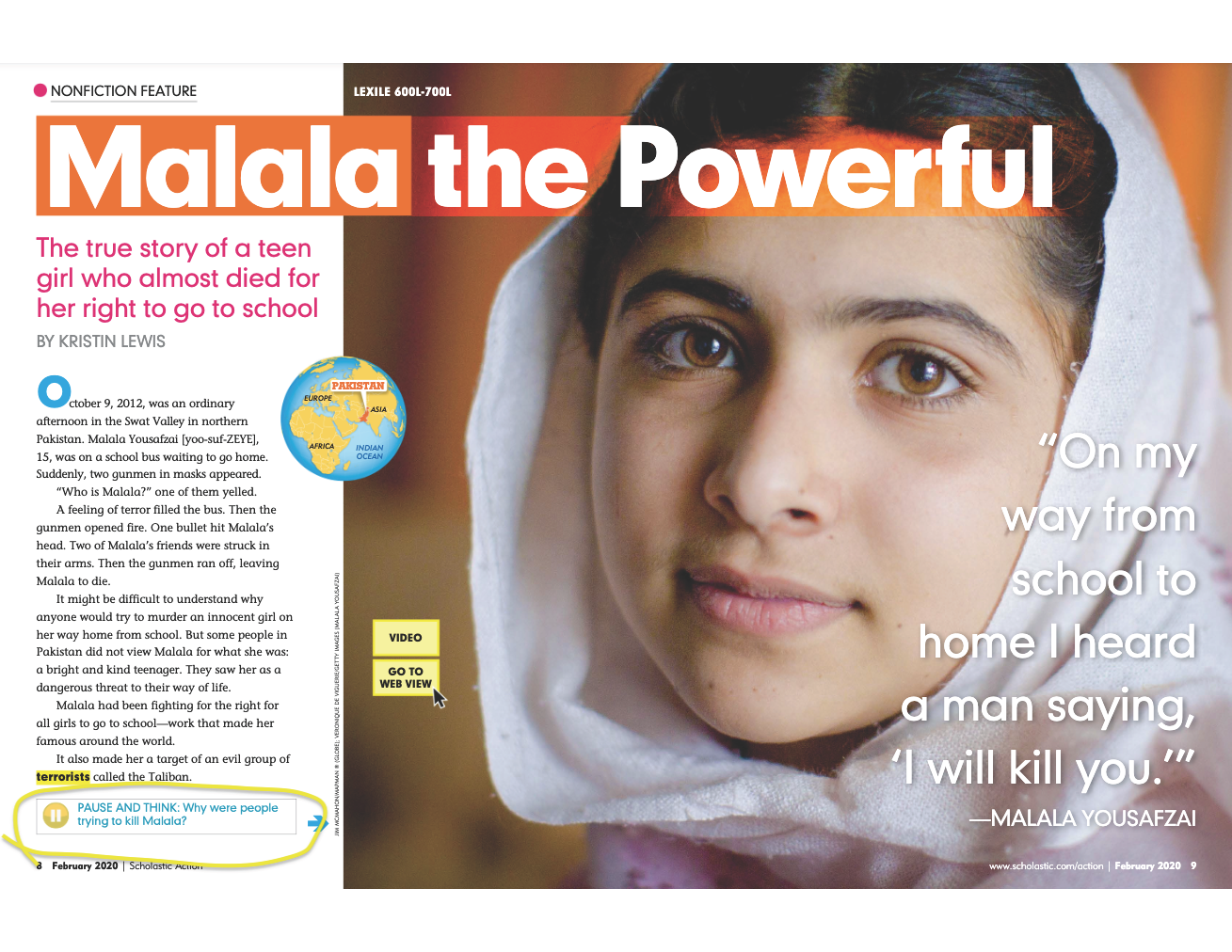
Malala the Powerful


Malala Yousafzai is an activist, survivor and the youngest Nobel Peace Prize winner in history. She’s also a must-teach topic during Women’s History Month.
But bringing her story to your struggling readers isn’t easy. The emotional content is heavy, and your students may not have the necessary background knowledge.
That’s why Action magazine is giving away “Malala the Powerful,” a highly engaging, accessible article with built-in support for striving readers in grades 6–12 (reading level 3–5).
This article and teaching package are available on Action’s website in three different Lexile® levels—along with Text-to-Speech audio, knowledge-building slideshows, a video, and more.
Here are some tips for getting the most out of this powerful article in your classroom.
Set a Purpose for Reading
Before you dive into the text, set a purpose for reading. You can pose an overarching question to your students about Malala’s story, and students can collect text evidence as they read. Try these questions with your class:
- How has Malala used her voice to make life better for herself and other girls?
- How can an individual make a difference in society?
- What does it mean to be resilient?
Familiarize Students with Key Words and Concepts
Your students may run into a lot of new vocabulary words, names and places while reading.
Make sure to use the vocabulary definitions that Action provides in the text, as well as the article’s vocabulary slideshow. For domain-specific vocabulary and more background knowledge, check out the Background Builder slideshow on Action Digital. Giving your students a base understanding of the more-difficult words and concepts they’ll encounter in the text will ensure they are prepared to easily digest new information.
Pause Throughout Reading to Answer Questions
Set up checkpoints throughout your reading lesson to stop and answer questions about the text together as a group. Action's already done the work for you with Pause & Think questions embedded right in the article:
You’ll find Pause & Think questions in every Action Nonfiction Feature and “In The News” story, making it easy to open up discussions and assess comprehension while you read.
Write About What You’ve Read
Writing prompts are a great way to help readers cement the information they've absorbed. But there’s no need to come up with your own. Every Action story includes a thought-provoking writing prompt, and “Malala the Powerful” is no exception:
Write a letter to Malala. What would you tell her? What did her story make you think about or question? How has her story inspired you to use your own voice for change?
Malala Yousafzai is an activist, survivor and the youngest Nobel Peace Prize winner in history. She’s also a must-teach topic during Women’s History Month.
But bringing her story to your struggling readers isn’t easy. The emotional content is heavy, and your students may not have the necessary background knowledge.
That’s why Action magazine is giving away “Malala the Powerful,” a highly engaging, accessible article with built-in support for striving readers in grades 6–12 (reading level 3–5).
This article and teaching package are available on Action’s website in three different Lexile® levels—along with Text-to-Speech audio, knowledge-building slideshows, a video, and more.
Here are some tips for getting the most out of this powerful article in your classroom.
Set a Purpose for Reading
Before you dive into the text, set a purpose for reading. You can pose an overarching question to your students about Malala’s story, and students can collect text evidence as they read. Try these questions with your class:
- How has Malala used her voice to make life better for herself and other girls?
- How can an individual make a difference in society?
- What does it mean to be resilient?
Familiarize Students with Key Words and Concepts
Your students may run into a lot of new vocabulary words, names and places while reading.
Make sure to use the vocabulary definitions that Action provides in the text, as well as the article’s vocabulary slideshow. For domain-specific vocabulary and more background knowledge, check out the Background Builder slideshow on Action Digital. Giving your students a base understanding of the more-difficult words and concepts they’ll encounter in the text will ensure they are prepared to easily digest new information.
Pause Throughout Reading to Answer Questions
Set up checkpoints throughout your reading lesson to stop and answer questions about the text together as a group. Action's already done the work for you with Pause & Think questions embedded right in the article:
You’ll find Pause & Think questions in every Action Nonfiction Feature and “In The News” story, making it easy to open up discussions and assess comprehension while you read.
Write About What You’ve Read
Writing prompts are a great way to help readers cement the information they've absorbed. But there’s no need to come up with your own. Every Action story includes a thought-provoking writing prompt, and “Malala the Powerful” is no exception:
Write a letter to Malala. What would you tell her? What did her story make you think about or question? How has her story inspired you to use your own voice for change?
Malala Yousafzai is an activist, survivor and the youngest Nobel Peace Prize winner in history. She’s also a must-teach topic during Women’s History Month.
But bringing her story to your struggling readers isn’t easy. The emotional content is heavy, and your students may not have the necessary background knowledge.
That’s why Action magazine is giving away “Malala the Powerful,” a highly engaging, accessible article with built-in support for striving readers in grades 6–12 (reading level 3–5).
This article and teaching package are available on Action’s website in three different Lexile® levels—along with Text-to-Speech audio, knowledge-building slideshows, a video, and more.
Here are some tips for getting the most out of this powerful article in your classroom.
Set a Purpose for Reading
Before you dive into the text, set a purpose for reading. You can pose an overarching question to your students about Malala’s story, and students can collect text evidence as they read. Try these questions with your class:
- How has Malala used her voice to make life better for herself and other girls?
- How can an individual make a difference in society?
- What does it mean to be resilient?
Familiarize Students with Key Words and Concepts
Your students may run into a lot of new vocabulary words, names and places while reading.
Make sure to use the vocabulary definitions that Action provides in the text, as well as the article’s vocabulary slideshow. For domain-specific vocabulary and more background knowledge, check out the Background Builder slideshow on Action Digital. Giving your students a base understanding of the more-difficult words and concepts they’ll encounter in the text will ensure they are prepared to easily digest new information.
Pause Throughout Reading to Answer Questions
Set up checkpoints throughout your reading lesson to stop and answer questions about the text together as a group. Action's already done the work for you with Pause & Think questions embedded right in the article:
You’ll find Pause & Think questions in every Action Nonfiction Feature and “In The News” story, making it easy to open up discussions and assess comprehension while you read.
Write About What You’ve Read
Writing prompts are a great way to help readers cement the information they've absorbed. But there’s no need to come up with your own. Every Action story includes a thought-provoking writing prompt, and “Malala the Powerful” is no exception:
Write a letter to Malala. What would you tell her? What did her story make you think about or question? How has her story inspired you to use your own voice for change?
